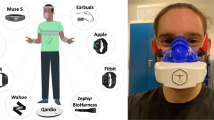Abstract
In the present study, we propose three new energy expenditure (EE) methods and evaluate their accuracy against state-of-the-art EE estimation commercialized devices. To this end, we used several sensors on 8 subjects to simultaneously record acceleration forces from wrist-located sensors and bio-potentials estimated from chest-located ECG devices. These subjects followed a protocol that included a wide range of intensities in a given set of activities, ranging from sedentary to vigorous. The results of the proposed human EE models were compared to indirect calorimetry EE estimated values (kcal/kg/h). The speed-based, heart rate-based and hybrid-based models are characterized by an RMSE of 1.22 ± 0.34 kcal/min, 1.53 ± 0.48 kcal/min and 1.03 ± 0.35 kcal/min, respectively. Based on the presented results, the proposed models provide a significant improvement over the state-of-the-art.
Chapter PDF
Similar content being viewed by others
References
World Health Organization: Prevention and control of noncommunicable diseases in the European region: A Progress Report, pp. 1–65 (2013)
Jensen, M.D., Ryan, D.H., Apovian, C.M., Ard, J.D., Comuzzie, A.G., Donato, K.A., Hu, F.B., Hubbard, V.S., Jakicic, J.M., Kushner, R.F., Loria, C.M., Millen, B.E., Nonas, C.A., Pi-Sunyer, F.X., Stevens, J., Stevens, V.J., Wadden, T.A., Wolfe, B.M., Yanovski, S.Z.: 2013 AHA/ACC/TOS Guideline for the management of overweight and obesity in adults: A report of the American College of Cardiology/American Heart Association Task Force on Practice Guidelines and The Obesity Society (2013) doi: 10.1161
Yamamura, C., Tanaka, S., Futami, J., Oka, J., Ishikawa-Takata, K., Kashiwazaki, H.: Activity diary method for predicting energy expenditure as evaluated by a whole-body indirect human calorimeter. J. Nutr. Sci. Vitaminol. 49(4), 262–269 (2003)
Stroud, M.A., Coward, W.A., Sawyer, M.B.: Measurements of Energy Expenditure Using Isotope-labelled Water (2H\(_{\rm 2}^{\rm 18}\)O) During an Arctic Expedition. Eur. J. Appl. Occup. Physiol. 67(4), 375–379 (1993)
Levine, J.A.: Measurement of energy expenditure. Public Health Nutrition. 8(7A), 1123–1132 (2005)
Bonomi, A.G., Plasqui, G., Goris, A.H.C., Westerterp, K.R.: Improving assessment of daily energy expenditure by identifying types of physical activity with single accelerometer. J. Appl. Physiol. 107(3), 655–661 (2009)
Rumo, M., Amft, O., Tröster, G., Mäder, U.: A stepwise validation of a wearable validation of a wearable system for estimating energy expenditure in field-based research. Physiol. Meas. 32(12), 1983–2001 (2011)
Van Hees, V.T., Ekelung, U.: Novel daily energy expenditure estimation by using objective activity type classification: Where do we go from here? J. Appl. Physiol. 107(3), 639–640 (2009)
Charlot, K., Cornolo, J., Borne, R., Brugniaux, J.V., Richalet, J.-P., Chapelot, D., Pichon, A.: Improvement of energy expenditure prediction from heart rate during running. Physiol. Meas. 35(2), 253–266 (2014)
Nielson, R., Vehrs, P.R., Fellingham, G.W., Hager, R., Prusak, K.A.: Step counts and energy expenditure as estimated by pedometry during treadmill walking at different stride frequencies. J. Phys. Act. Health. 8(7), 1004–1013 (2011)
Dannecker, K.L., Sazonov, N.A., Melanson, E.L., Sazonov, E.S., Browning, R.C.: A comparison of energy expenditure estimation of several physical activity monitors. Med. Sci. Sports Exerc. 45(11), 2105–2112 (2013)
Ergogan, A., Cetin, C., Karatosun, H., Baydar, M.L.: Accuracy of the Polar S810iTM heart rate monitor and the Sensewear Pro ArmbandTM to estimate energy expenditure of indoor rowing exercise in overweight and obese individuals. J. Sports Sci. Med. 9, 508–516 (2010)
Author information
Authors and Affiliations
Editor information
Editors and Affiliations
Rights and permissions
Copyright information
© 2014 Springer International Publishing Switzerland
About this paper
Cite this paper
Delgado-Gonzalo, R. et al. (2014). Human Energy Expenditure Models: Beyond State-of-the-Art Commercialized Embedded Algorithms. In: Duffy, V.G. (eds) Digital Human Modeling. Applications in Health, Safety, Ergonomics and Risk Management. DHM 2014. Lecture Notes in Computer Science, vol 8529. Springer, Cham. https://doi.org/10.1007/978-3-319-07725-3_1
Download citation
DOI: https://doi.org/10.1007/978-3-319-07725-3_1
Publisher Name: Springer, Cham
Print ISBN: 978-3-319-07724-6
Online ISBN: 978-3-319-07725-3
eBook Packages: Computer ScienceComputer Science (R0)




